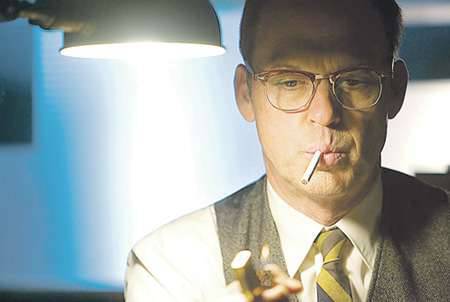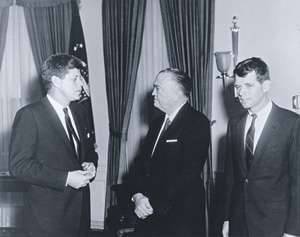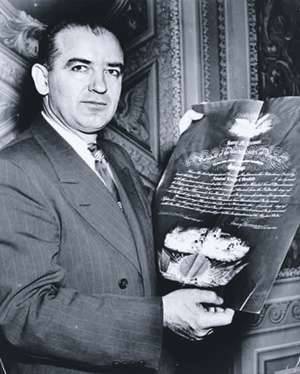American counterintelligence during the Cold War

Literally a year and a half after the end of the Second World War, a new, so-called Cold War began, into which the former allies in the face of the Anglo-axes and their satellites, on the one hand, and the USSR and its allies, on the other, were drawn. Ensuing confrontation was carried out against the backdrop of an unprecedented tightening of the conservative regime in the United States, large-scale repression against the Left (communist or even socialist / social democratic) forces, constantly fueled by a manifestation of the so-called McCarthy (on behalf of the influential ultra-conservative Senator Joseph McCarthy of Wisconsin), everywhere created verification commissions "on loyalty", etc.
The main instrument in the implementation of such a course in the domestic political arena in the United States was a special services conglomerate with the leading role of the Federal Bureau of Investigation (FBI) and military counterintelligence associated with it. Checks for loyalty, overt and covert, in the American armed forces led to their “cleansing” of any dissent and turned into a fairly powerful and fully obedient to the authorities means of conducting an imperialist course in the foreign policy arena.
TRANSFERS, REQUESTS, REPRESSIONS
Having experience in ensuring the security of international conferences, beginning with the Paris Conference following the First World War, the United States military intelligence and counterintelligence officers took an active part in similar preparations for the first and then subsequent sessions of the United Nations General Assembly and other events in within the organization in the United States, including as translators.
In the early postwar years, the leadership of military counterintelligence took unprecedented active operations in all the states of Europe and the Pacific zone controlled by the US occupation regime. Employees of the US military intelligence services obtained intelligence information from captured documents, polls of prisoners of war, interned persons, former partisans and insurgents. They were also tasked with ensuring the security of military installations and zones, searching for and arresting “enemy” agents and opening up espionage networks, training special national divisions on the features of censorship, searching for the necessary documents and methods to counteract the introduction of disinformation. At first, counterintelligence officers even performed the tasks of the so-called occupation commandant's offices, until they were replaced by appropriately trained units, including the military police, closely associated with counterintelligence.
During the preparation for the International Nuremberg Tribunal for Nazi Criminals, US military intelligence and counterintelligence officers were involved in the operations of Charter, Alsos, Sklipka, Bluebird (Artichoke), supervised by the Central Intelligence Agency of the United States (since 1947) "MK-Ultra" ("Monarch") and others who had the goal of identifying German specialists and researchers in the fields of nuclear weapons, rocket technology, cryptography, medicine (psychology), robotics, etc. with their subsequent shipment to the United States. Moreover, the facts of repeated “cover-up” by American counterintelligence war criminals, who under one pretext or another “took away” from responsibility and helped to travel to states, for example, South America, where they “dissolved” among the local population and avoided criminal prosecution. Acting in the countries occupied by the US, US military counterintelligence officers took an active part in the beginning of the Cold War.
FIRST POST-WAR

With the formation of the Central Intelligence Agency (CIA) in 1947 and the introduction of the post of Director of Central Intelligence (CRR), all intelligence and counterintelligence activities in the country were, in fact, concentrated in a single center - the CIA. After the successful (“not without the help of Soviet agents”) the Soviet Union’s detonation of a nuclear device in 1949, the Joint Chiefs of Staff (USP) of the United States Armed Forces published its fundamental considerations according to which during the war all counterintelligence activities in the country should be controlled military that the military tried to do in 1951 during the Korean War. However, the director of the central intelligence was able to convince the country's leadership that such a concentration of special services during the war, as they say, in one hand, that is, the military, is “irrational”.
As a result, already in 50-s, the leadership of the United States realized the fact of the “redundancy” of national special services, which not only began to duplicate functions, but also often trivially impeded the work of their colleagues. In this regard, military intelligence and counterintelligence stood out. Despite repeated reminders of inadmissibility by lawmakers for the military department and its subordinate structures for conducting any intelligence activities within the country, intelligence officers of the United States Armed Forces continued to develop extensive networks of ties with local law enforcement agencies, the so-called patriotic organizations, and against this background, they actually connected to sanctioned measures by some ultra-right politicians and legislators to “curb anti-American oh activity. " It is noteworthy that this activity of military intelligence and counterintelligence agents was really encouraged by the leadership of the Ministry of Defense under the pretext of “combating communist influence and instilling a sense of patriotism among the population”. Formally, the secret OKNSH directive from 1958 of the year served as the legal impetus to this type of activity, which obliged the US Armed Forces to focus on countering communist propaganda. From now on, for example, the intelligence division of the headquarters of each army corps was obliged to compile weekly intelligence reports on the so-called internal subversive activities in the units and formations of the national Armed Forces.
In 1958, the Federal Bureau of Investigation, on the initiative of its director John Edgar Hoover, jointly with military counterintelligence, planned the operation, later known as “Shocker” (Espionage, Soviet-United States-History), whose goal was to introduce its agents into the “enemy” intelligence. The plan of the operation, as evidenced by the famous American researcher David Wise, was to identify individuals who could be of interest to Soviet intelligence, including among US military personnel. In essence, the Americans intended to misinform their geopolitical adversary in all possible areas, including military construction. Wise testifies that the efforts of the American counterintelligence during this year, which lasted 23 (!), Were not in vain, and in some cases they managed to achieve the desired results, that is, to misinform the "enemy" and expose the "Soviet agents."
Meanwhile, gradually the activity of military counterintelligence began to go beyond the “permissible boundaries" when, in particular, the network of their informers covered many educational institutions of the country - from secondary schools to universities of almost all states. Thus, during the parliamentary investigation of 1960, the fact was revealed that "military counterintelligence allocated 1,5 thousand agents only to monitor the usual, usually anti-war, demonstrations throughout the country." In addition, other obviously illegal actions of counterintelligence have become public, in particular, the fact that military counterintelligence agents installed listening devices in the room of the then President of the country Eleanor Roosevelt during the war.
In the end, lawmakers rendered their verdict: military intelligence clearly exceeds its authority and violates the law. As one of the measures to streamline the activities of the special services, including within the framework of the country's armed forces, in 1961, all the counter-intelligence agencies of the Armed Forces were consolidated into a single structure within the United States Department of Defense Intelligence Agency (RUMO). To some extent, this undermined the authority of the CIA and even the FBI as “the main coordinating bodies of the country's special services,” including counterintelligence. But at the same time, the sufficiently broad counterintelligence powers of the Federal Bureau of Investigation still remained virtually intact.
In the second half of 60, lawmakers again tried to “limit permissiveness” of counterintelligence agents by passing a law on controlling organized crime through Congress in 1968, according to which it was strictly forbidden to “wiretap” without a court order, and again imposed some restrictions on work including counterintelligence services in the United States. But in the middle of the 70-s, by decrees of presidents Ford and then Carter, some restrictions were relaxed, which allowed counterintelligence agents to toughen actions against real and "imaginary" "enemies of the country."
In general, 50 – 70s of the last century are considered by many researchers of the US special services as the “flourishing” of counterintelligence, including military ones. It was during this period that the powerful foundations of a very specific work of counterintelligence, aimed at identifying "enemy agents", including in the ranks of the American armed forces, were laid.
"RISE" AND LIMITATIONS
A number of specialists associate the emergence and consolidation of harsh methods of counterintelligence by US intelligence in the mid 50-s with the name of James Angleton, appointed in 1954, the central intelligence director (he is the CIA director) Allen Dulles as head of the counterintelligence operations department of the Central Intelligence Agency. Angleton’s quite successful implementation methods (in fact, total surveillance), on the one hand, caused “jealousy” among FBI employees and personally, John Edgar Hoover, the long-term director of this service, and on the other, massively introduced into the practical work of all special services, one way or another associated with counterintelligence activities, including primarily the Federal Bureau of Investigation.
James Angleton was famous for the fact that even during World War II, as an employee of the CIA forerunner, the Office of Strategic Services of the United States, he was sent to the UK as his representative to enrich his experience, fulfill the duties of an employee in the London branch of American counterintelligence (X-2) and direct, albeit with limited access, work together with the British during the implementation of the ultra-secret Operation Ultra to open the German military and diplomatic codes. According to the recollections of his colleagues, the future head of the CIA counterintelligence service was impressed by the "perfectly organized" British security of the events held and, as it turned out, the almost absolute exclusion of information leaks that would allow opponents (Germany and its satellites) and allies (USSR ) use the fruits of British cryptographers. After the end of the Second World War and during his work at the leading post at the CIA, James Angleton, with the support of virtually all leaders of American political intelligence, advocated the strict observance of strict requirements imposed on British employees for not only counterintelligence, but also intelligence. In particular, he admired the selection of employees to work in the British special services, when secret information allowed only those who must be born in the UK and at least two generations whose families must live in the United Kingdom.

The success of the Soviet intelligence services in penetrating the structures of Western intelligence and security agencies was not only a “sobering” factor for the leaders of American counterintelligence, but also forced them to improve methods of counterintelligence. On the recommendation of unconditional authority among the intelligence services of Angleton, the leadership of the CIA constantly insisted on the close coordination of the counter-intelligence activities of all the services included in the US Intelligence Community. Naturally, by virtue of functional duties and in accordance with the law, the Federal Bureau of Investigation belonged to and continues to play a coordinating role in this activity, on the recommendation of which the US administration periodically updates the so-called lists of particularly important threats, including in the military sphere, and to counteract them special services of the country to combine their efforts.
However, the excessive intelligence efforts of counterintelligence, as it was later determined during investigations on the results of the work of the special services, often hampered the “elite segment” of the Intelligence Society - intelligence officers to fulfill their direct duties. For example, conflicts between the CIA and RUMO have repeatedly arisen due to the fact that Angleton and his staff constantly interfered in the specific recruiting work of military intelligence officers, suspected recruited agents and defectors of “working for the enemy” and thus disrupting “promising operations”. At the same time, the CIA counterintelligence and military counterintelligence officers continued to expand the network of their agents in the United States, activating the “struggle with the internal enemy,” which once again was evidence of a direct violation of US law. As a result of several Senate investigations of the beginning and middle of the 70-ies (Murphy commissions, Church and others), legislators again adopted laws and by-laws restricting the activities of special services, mainly against American citizens in the United States. The heads of counterintelligence agencies were also subjected to severe repression. By the decision of the Central Intelligence Director William Colby in December 1974, James Angleton and his entire “team” were dismissed. Employees of other counterintelligence services, including military counterintelligence, were also subjected to certain, but less severe reprisals.
However, the formulation of a counterintelligence strategy in the United States and, accordingly, the main role in this area continued to belong to the FBI. The director of the bureau, John Edgar Hoover, with the approval of the presidential administration back in 1956, proposed to the country's leadership a so-called counter-intelligence program, to the implementation of which, under the “patronage” of the FBI, the relevant structures of all members of the US intelligence community, including military counterintelligence, were involved.
Washington's involvement in numerous military actions abroad, and above all in the war in Southeast Asia in the 60 – 70 of the last century, generated an unprecedented wave of protests inside the country, to “neutralize” which counterintelligence efforts were directed. The leadership of the special services believed that intelligence agents of Washington, primarily the Soviet Union, were involved in these actions, which caused significant damage to the prestige of the United States. The situation really was not the best way. Suffice it to cite the following example: by the end of the 60s, more than 65 of thousands of servicemen deserted from the US Armed Forces, which was equivalent to four infantry divisions.
It is noteworthy that the famous political scientist Samuel Huntington in one of his historical research states the fact of an unprecedented decline in American loyalty to their government in the 70s of the last century. It was during this period, as noted by many researchers, that there were numerous cases of recruitment of American citizens by foreign intelligence services, including members of the US Armed Forces. The situation for counterintelligence was aggravated by constant violations of domestic American law by the American special services, which could not but attract the attention of various public organizations and legislators. Due to the fact that many counterintelligence operations directly violated the rights of large masses of American citizens, a Senate committee chaired by Senator Frank Church in 1975 categorically banned this kind of activity as “contrary to the First Amendment of the country's Constitution, which guarantees freedom of speech and press ".
THE NEXT “REVIVAL”
When the republican administration headed by right-wing representative Ronald Reagan came to power in the United States at the beginning of the 80-s, the situation in the country gradually began to change towards a tightening of the counter-intelligence regime, the resumption of total surveillance of so-called non-patriots and mass checks on the subject of “loyalty to the state” and national values "that apply to all sectors of American society, including the armed forces. From the point of view of counterintelligence, it was during this period that “impressive successes in her work” were achieved.
Michael Sulik, a researcher in the history of special services, referring to documents of the Center for the Research and Protection of Personnel of the US Department of Defense, cites data indicating that more than 80 Americans were arrested for espionage during the relatively short period of the second half of the 60's. Moreover, the vast majority of them were military men who agreed to work for the Soviet and allied intelligence, mainly allegedly for commercial interests. Naturally, the responsibility for these “failures” was assigned to the military counterintelligence, which could not “neutralize the impending threat” in time. The military, however, in their defense said that the recruitment took place at a time when counterintelligence was "practically neutralized" and was in a "humiliated position", that is, during the period of widespread exposure of its shares that went beyond the law. Nevertheless, Sulik continues, starting from the end of the 80s and over the next decade, a series of measures were taken in the army structures "affected by espionage", which ultimately allowed to significantly tighten the security system, to which the military was directly involved United States counterintelligence.
Interestingly, with the collapse of the Warsaw Pact and the disintegration of the Soviet Union, the amount of work for the American counterintelligence was not diminished. According to the authoritative counterintelligence specialist Joel Brenner, more than 1990 foreign intelligence intelligence services “worked” at the turn of 2000 – 140-s against the United States. This allegedly demanded from the leadership of the country not only the preservation of the counter-intelligence potential developed over the long years of the Cold War, but also its constant build-up.
From the editorial board
March 25 to Major General Sergei Leonidovich Pechurov marks 65 years. Honored Military Specialist of the Russian Federation, Doctor of Military Sciences, Professor Sergey Leonidovich Pechurov is a regular contributor to Independent Military Review. The editors congratulate Sergey Leonidovich on his jubilee and wish him wholeheartedly good health, further fruitful work for the benefit of our Motherland, success in the field of military scientific research, as well as in literary and social activities.
Information